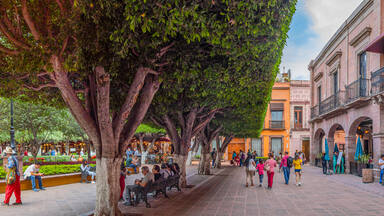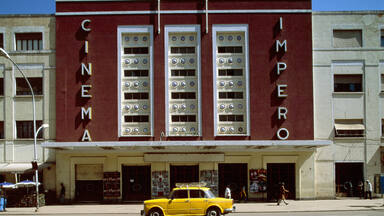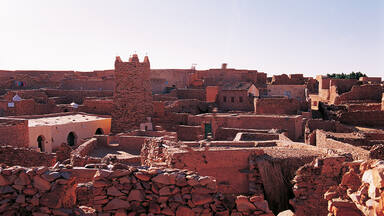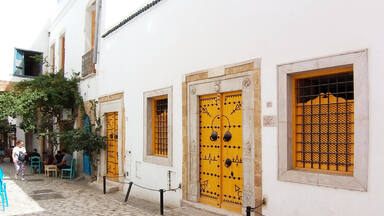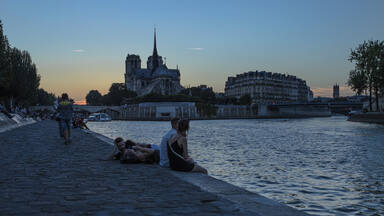"Under the Almohads and the Hafsids, from the 12th to the 16th century, Tunis was considered one of the greatest and wealthiest cities in the Islamic world. Some 700 monuments, including palaces, mosques, mausoleums, madrasas and fountains, testify to this remarkable past."
Historic building attributes
"Under the Almohads and the Hafsids, from the 12th to the 16th century, Tunis was considered one of the greatest and wealthiest cities in the Arab world. Between the 16th and 19th centuries, new powers endowed the city with numerous palaces and residences, great mosques, zaouias and madrasas."
The Medina contains over 80 listed monuments, including religious monuments, mosques such as Al-zaytouna Mosque, the Kasbah and Youssef Dey, and mausoleums such as Tourbet el Bey; palaces and noble houses such as Dar el-Bey, Dar Hussein, Dar Ben Abdallah and Dar Lasram; educational institutions, including medrasahs such as Es- Slimanya and El-Mouradia, and the Zaouia of Sidi Mehrez, and government buildings such as the El Attarine military barracks.
Traditional dwellings
The courtyard house is a common model for domestic architecture in North Africa and the Middle East. The Medina of Tunis courtyard houses follow a similar typology to other historical Islamic cities, adapted to local traditions, construction materials and environmental factors. Their plan is introverted, with rooms looking towards the central open space, which provides privacy and comfort.
Attributes of urban elements
The Medina of Tunis is one of the first Arabo-Muslim towns of the Maghreb (698 A.D.). Capital of several universally influential dynasties, it bears witness to the interaction between architecture, urbanism and the effects of socio-cultural and economic changes of earlier cultures". The relay role played by the Medina of Tunis between the Maghreb, Southern Europe and the East encouraged exchanges of influences in the field of the arts and architecture over many centuries. As an important city and capital of different dynasties, the Medina of Tunis offers an exceptional testimony of the civilisations of Ifriqiya from the 10th century onwards.
The Medina of Tunis is a representative example of the North-African Islamic city typology. Historic centres of traditional North-African cities are known as Medina (city, in Arabic). Medinas are typically surrounded by thick city walls with gates. Inside, courtyard buildings two to three stories high are closely placed together. This homogeneous landscape is punctuated by minarets, which rise above narrow lanes and twisting streets. Streets and courtyards remain cool and shaded during the summer heat.
The World Heritage property includes the 8th-century Medina and the 13th Century neighbourhoods to the North and South and some 700 historical monuments. The Medina, as an ensemble, has conserved the integrity of its urban fabric with all its typo-morphological components, including:
- Dense urban settlement pattern with narrow, twisting streets.
- Residential quarters of uniform height, following a similar dwelling typology of middle-height courtyard buildings.
- Remains of city walls, including gates of Bab-Jedid and Bab El-Bhar.
- Markets such as the Souq el-Attarine and Souq ech-Chaouachia.
Attributes of the wider setting of the city or settlement
Located in a fertile plain region of north-eastern Tunisia and a few kilometres from the sea, Tunis is a large city of over one million inhabitants, expanding over a metropolitan area of 212 km2. Once a small Berber town (oppidum tunicense) linked to the ancient Punic capital of Carthage, the Medina of Tunis saw a significant development after the destruction of Carthage in the 8th century.
Intangible heritage values
The Medina of Tunis "bears witness to the interaction between architecture, urbanism and the effects of socio-cultural and economic changes of earlier cultures" (SOUV) and developed an influence in the development of the arts in the Islamic context. The World Heritage Nomination Dossier 36 (1979) indicates that traditional trading activities took place in the Medina, a social and economic practice threatened by competition from other parts of the city.
The Medina of Tunis, a city of festivals
Contribution by Mr Montassar Jmour, site manager, “Medina of Tunis”
During Ramadan, the palaces and cultural centres of the medina open their doors for concerts, recitals and various shows. Evenings of tarab theatrical dance, music with a religious connotation (Sufi, gospel...), Arabic or Andalusian music continue the ancestral traditions and bring to the attention of the public the budding talents of tomorrow. The shows are developed by artists. The festivals include a diversity of rhythms and music, bringing together local residents to recharge their batteries and remember that the heart of the city is also part of their own heart.
In the heart of the Medina, a melting pot of civilisations, the Ramadan festival brings together more than fifty Arab, African and European artists, with innovative art installations that change over the course of the editions.
The residents of the medina join the cultural events, which have become "their" events as they take place on their territory. Residents have free access to all cultural festivals, and are often involved in the organization of the events.
Amongst other objectives, the festivals aim to highlight the artisanal, historical, geographical and cultural heritage of Tunis while promote the Medina as a tourist destination.
This celebration has become an important tourist attraction thanks to its uniqueness and originality rich in light and colour. It brings new life and rhythms to the Medina, making residents and visitors alike enjoy its rich heritage.
References
- ICOMOS. (1997). Advisory Body Evaluation. whc.unesco.org/document/153265
- Request for a Minor Boundary modification. (2010). whc.unesco.org/document/169649
- Request for international assistance (Dar El Haddad courtyard house). (1966). UNESCO Archives.
- UNESCO World Heritage Centre. (2023).The World Heritage List: Medina of Tunis.
whc.unesco.org/en/list/36/ - World Heritage Committee, 34th Session. (2010). Decision 34 COM 8E. whc.unesco.org/en/decisions/4261
- World Heritage Committee, 34th Session. (2010). Document WHC-10/34.COM/8E. whc.unesco.org/archive/2010/whc10-34com-8Ee.pdf
- World Heritage Nomination Dossier 36. (1979). UNESCO Archives.
Links
- Medina of Tunis, inscribed on the World Heritage List (1979).
- Tunis, UNESCO Creative City of Crafts and Folk Art (2017).
- Harissa, knowledge, skills and culinary and social practices, inscribed on the Representative List of Intangible Cultural Heritage of Humanity (2022).
- Arabic calligraphy: knowledge, skills and practices, inscribed on the Representative List of Intangible Cultural Heritage of Humanity (2021).
- Knowledge, know-how and practices pertaining to the production and consumption of couscous, inscribed on the Representative List of Intangible Cultural Heritage of Humanity (2020).
© UNESCO, 2023.
Project team: Jyoti Hosagrahar, Mirna Ashraf Ali, Alba Zamarbide, Carlota Marijuan Rodriguez, Giacomo Martinis, Marta Zerbini.
* Illustrations marked with an asterisk have all rights reserved. Permission is required for their reuse.
Decisions / Resolutions (1)
The World Heritage Committee,
1. Having examined Document WHC-10/34.COM/8E,
2. Adopts the retrospective Statements of Outstanding Universal Value, as presented in the Annex I of Documents WHC-10/34.COM/8E, WHC-10/34.COM/8E.Add and WHC-10/34.COM/8E.Add.2 for the following World Heritage properties:
- Algeria: Al Qal'a of Beni Hammad; M'Zab Valley; Djémila; Tipasa; Tassili n'Ajjer; Timgad; Kasbah of Algiers;
- Austria: Historic Centre of the City of Salzburg; Palace and Gardens of Schönbrunn; Hallstatt-Dachstein / Salzkammergut Cultural Landscape;
- Bulgaria: Boyana Church; Madara Rider; Thracian Tomb of Kazanlak; Rock-Hewn Churches of Ivanovo; Rila Monastery; Ancient City of Nessebar; Thracian Tomb of Sveshtari;
- Côte d'Ivoire: Comoé National Park;
- Democratic Republic of the Congo: Okapi Wildlife Reserve;
- Denmark: Jelling Mounds, Runic Stones and Church; Roskilde Cathedral;
- Ethiopia: SimienNational Park;
- Israel: Masada; Old City of Acre; White City of Tel-Aviv - the Modern Movement; Incense Route - Desert Cities in the Negev; Biblical Tels - Megiddo, Hazor, Beer Sheba;
- Jordan: Petra; Quseir Amra; Um er-Rasas (Kastrom Mefa'a);
- Lebanon: Anjar; Byblos; Baalbek; Tyre; Ouadi Qadisha (the Holy Valley) and the Forest of the Cedars of God (Horsh Arz-el-Rab);
- Malawi: Lake Malawi National Park;
- Mauritania: Banc d'Arguin National Park; Ancient Ksour of Ouadane, Chinguetti, Tichitt and Oualata;
- Morocco: Ksar of Ait-Ben-Haddou; Historic City of Meknes; Archaeological Site of Volubilis; Medina of Essaouira (formerly Mogador); Medina of Fez; Medina of Marrakesh; Medina of Tétouan (formerly known as Titawin); Portuguese City of Mazagan (El Jadida);
- Niger: Air and Ténéré Natural Reserves; W National Park of Niger;
- Oman: Bahla Fort;
- Portugal: Laurisilva of Madeira;
- Senegal: Island of Gorée; Niokolo-Koba National Park;
- Seychelles: Aldabra Atoll; Vallée de Mai Nature Reserve;
- South Africa: Fossil Hominid Sites of Sterkfontein, Swartkrans, Kromdraai, and Environs.
- Spain: Cathedral, Alcázar and Archivo de Indias in Seville ;
- Sudan: Gebel Barkal and the Sites of the Napatan Region;
- Syrian Arab Republic: Ancient City of Bosra; Ancient City of Aleppo; Crac des Chevaliers and Qal'at Salah El-Din; City of Damascus; Site of Palmyra;
- Tunisia: Archaeological Site of Carthage; Amphitheatre of El Jem; Ichkeul National Park; Medina of Sousse; Kairouan; Medina of Tunis; Punic Town of Kerkuane and its Necropolis; Dougga / Thugga;
- Uganda: Tombs of Buganda Kings at Kasubi;
- United Kingdom of Great Britain and Northern Ireland: Saltaire; Dorset and East Devon Coast; Derwent Valley Mills; Royal Botanic Gardens, Kew; Liverpool - Maritime Mercantile City; Cornwall and West Devon Mining Landscape.
- United Republic of Tanzania: Selous Game Reserve; Kilimanjaro National Park;
- Yemen: Historic Town of Zabid;
3. Decides that retrospective Statements of Outstanding Universal Value for World Heritage properties in Danger will be reviewed in priority;
4. Further decides that, considering the high number of retrospective Statements of Outstanding Universal Value to be examined, the order in which they will be reviewed will follow the Second Cycle of Periodic Reporting, namely:
- World Heritage properties in the Arab States;
- World Heritage properties in Africa;
- World Heritage properties in Asia and the Pacific;
- World Heritage properties in Latin America and the Caribbean;
- World Heritage properties in Europe and North America.
